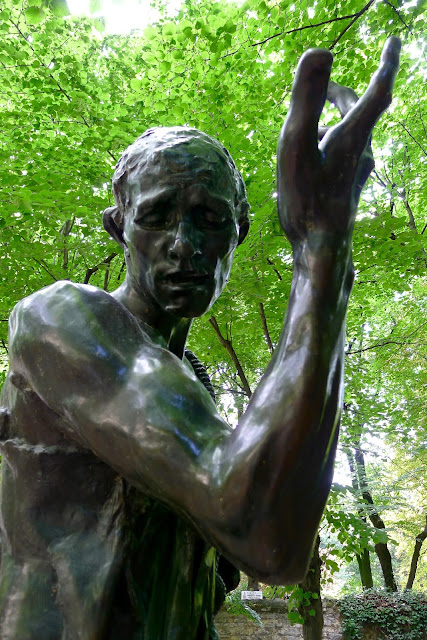I have been to the Louvre, Musee D'Orsay, Centre Pompidou, Picasso Museum, and many other places that display some of the most spectacular art collections in the world. Sometime down the road I might revisit a couple of them, but there are two museums, which I make a point of seeing practically each time I am in Paris: L'Orangerie and Musee Rodin.
I think that the hassle of visiting some of the larger museums is just too much for me personally. I prefer a calm setting of a smaller museum which is not packed to the brim with people, a place where one can wander in peace, sit down, reflect, and leave rejuvenated.
This museum, located in a mansion named Hotel Biron, first opened to the public in 1919. It was originally built between 1727-1732 , some of the more notable residents were Jean Cocteau and Henri Matisse. In 1908 Auguste Rodin began to rent four south-facing, ground-floor rooms, which opened onto the terrace. By 1911on, Rodin occupied the entire building, but the estate was sold to the French government. In order to save the mansion Rodin gave all of his works to the State but asked for them to be kept at the Hotel Biron, which would become the Musee Rodin. He also asked for the right to reside there for the rest of his life.
The museum underwent a large renovation but it is now fully open to the public.
I did not see "The Kiss" - 1882 - during my last visit, this photo is from a previous visit to the museum. Here is the description from the Musee Rodin website:
"The Kiss originally represented Paolo and Francesca, two characters borrowed, once again, from Dante's "Divine Comedy": slain by Francesca's husband who surprised them as they exchanged their first kiss, the two lovers were condemned to wander eternally through Hell. This group, designed in the early stages of the elaboration of The Gates, was given a prominent position on the lower left door, opposite Ugolino, until 1886, when Rodin decided that this depiction of happiness and sensuality was incongruous with the theme of his vast project."
The Thinker, originally conceived as part of The Gates of Hell, but started to be exhibited individually in 1888 and enlarged in 1904. Probably one of the most celebrated sculptures ever.
The Gates of Hell - 1880-1890
Inspired by Dante's "Divine Comedy", a poem in which the author describes his journey through Hell, Purgatory, and Paradise.
This version of The Gates of Hell is at the Musee D'Orsay.
The beautiful garden filled with flowers and sculptures is just stunning and one of the more peaceful places in Paris. I sometimes come here to take photos of pastries.
The Burghers of Calais (1889)- a monument to the heroism of six burghers (members of the mercantile class of a medieval European city) in Calais during a siege by England in the Hundred Years' War in 1347.
The Three Shades - 1886
The souls of the damned from Dante's Divine Comedy stand at the entrance to hell.
Ugolino and His Sons - 1881
This sculpture happens to be my personal favorite, it was just moved to be a centerpiece in this ornamental pond.
Ugolino della Gherardesca was a Count and a politician who lived in Pisa in the 13th century. He was tried for betrayal, arrested along with his children and grandchildren, and imprisoned at the Muda Tower, where they all died of starvation after nine months. Dante wrote about Ugolino in The Divine Comedy and Rodin placed the Count with his sons as part of the Gates of Hell.
I was very moved when I saw this piece for the first time. Not knowing anything about it, I was free to interpret it as an anguish of a father after possibly finding his son dead. I thought that the father found his son dead, fell to his knees in agony along with the two other boys. The sheer pain of the adult can be sensed in the tension of the muscles, the kneeling posture, and the open mouth, which seems to be letting out a deep wail. Well, I was wrong. Upon returning home I decided to look up the information on the sculpture that had such an effect on me. It actually portrays Ugolino, desperate and dying of starvation and eating the bodies of his dead children before dying himself. His hyena like crawling position is meant to reinforce the inhumanity of his action; he had been stripped of all human dignity.
So, I was off a bit, but knowing the story behind this sculpture made me love it even more. It is one of the saddest and most powerful pieces I have ever seen.
Before Ugolino was moved to the pond it resided in the sculpture garden.
Musee Rodin
77 rue de Varenne
Open everyday except for Mondays
10-5:45
I usually buy tickets online but the line to purchase tickets at the museum is never very long.
Joanna
































Comments
Post a Comment